Rural Health Matters: Addressing the Unique Challenges of America’s Rural Communities

What do you picture when you hear the word rural? Do you see a particular landscape or town? Do you think of a particular industry? What do the people look like? What you pictured probably depends on what rural looks like near you but every state has rural areas. So how then do we define rural when rural is so diverse?
Defining what it means to be rural can be challenging and it’s challenging to the point that the US federal government doesn’t have one definition. A variety of definitions, at the federal and state level, have been created as part of criteria for eligibility for programs, grants, and regulations.
The broadest definition, and the one people may see most often, comes from the US Census Bureau, which doesn’t define rural directly, but instead classifies anything that isn’t urban as rural. The Census definition was updated for the 2020 Census with urban being defined as “at least 2,000 housing units or has a population of at least 5,000.” In this case, a population of 4,999 or less would be rural by default.
So what do those definitions mean in practice? It means about 15%-20% of Americans live in rural areas as of the 2020 census. Furthermore, according to the Carsey School of Public Policy at the University of New Hampshire, demographics in rural areas have shifted from the 2010 to 2020 census. Rural residents still tend to be older, but younger residents tend to be more racially diverse. Nearly one-third of children in rural areas come from racial or ethnic minority populations up from 28% in the previous census.
How Does Living in a Rural Area Affect Your Health?
Evidence shows that there are marked health disparities between those living in rural areas versus their urban counterparts, due in part to demographic, environmental, economic, and social factors.
According to the CDC, these factors include an older population, higher rates of cigarette smoking and obesity, and higher rates of poverty. Rural residents often have limited broadband service, and must travel long distances to get routine checkups and screenings. They also are more likely to have limited access to primary care services and to be uninsured or under-insured. Addressing these challenges requires unique and innovative approaches to providing health care.
The following resources can help you understand and meet the health information needs of those living in rural communities.
- MedlinePlus Rural Health Concerns Health Topics page
- RHIHub: Rural Health Information Hub
- CDC: Rural Health
- SAMHSA: Rural Behavioral Health
Join NNLM this November as we Explore Rural Health
 NNLM is hosting a free, virtual rural health webinar series this month in recognition of National Rural Health Day on November 21st. This series is an exploration of the efforts that communities take to address the unique health needs of rural populations in the US, and aims to provide practical evidence-based solutions that support librarians, health educators, community leaders, and direct care providers to improve rural health outcomes. The series runs from November 6-21, and includes the webinars below. Click on the links to register for each session or check out the Rural Health Webinar Series page on NNLM.gov.
NNLM is hosting a free, virtual rural health webinar series this month in recognition of National Rural Health Day on November 21st. This series is an exploration of the efforts that communities take to address the unique health needs of rural populations in the US, and aims to provide practical evidence-based solutions that support librarians, health educators, community leaders, and direct care providers to improve rural health outcomes. The series runs from November 6-21, and includes the webinars below. Click on the links to register for each session or check out the Rural Health Webinar Series page on NNLM.gov.
- Building Healthy, Resilient Communities in Florida’s Rural Panhandle
- Facilitating Rural Access to Quality Health Information through Little Free Libraries
- Graphic Medicine Discussion: The Most Costly Journey
- When Your Community Is Your Hospital
- Promoting Walking for Health in Rural Communities
- Palmetto Connect: Fostering Digital Inclusion in Rural South Carolina
- Social Connectedness and Improving the Health of Rural Communities
- Rural Health Resources
 The NNLM Reading Club will also focus on rural health in November. The Reading Club supports your library community planning by recommending three rural health related books, materials and discussion guides for each recommended book which can be downloaded from the NNLM web site, and links to relevant NLM, NIH, and other health agency resources.
The NNLM Reading Club will also focus on rural health in November. The Reading Club supports your library community planning by recommending three rural health related books, materials and discussion guides for each recommended book which can be downloaded from the NNLM web site, and links to relevant NLM, NIH, and other health agency resources.
[Insert image: NNLM Reading Club]
The three featured books for November are:
- The Hospital: Life, Death, and Dollars in a Small American Town by Brian Alexander
- The Most Costly Journey by Marek Bennett (This book will be the focus of the NNLM Rural Health Webinar Series session on November 12, Graphic Medicine Discussion: The Most Costly Journey.)
- Wastelands: The True Story of farm Country on Trial by Corban Addison
We invite you to learn with us this month and beyond!
Tags: NNLM, ruralhealthresources












